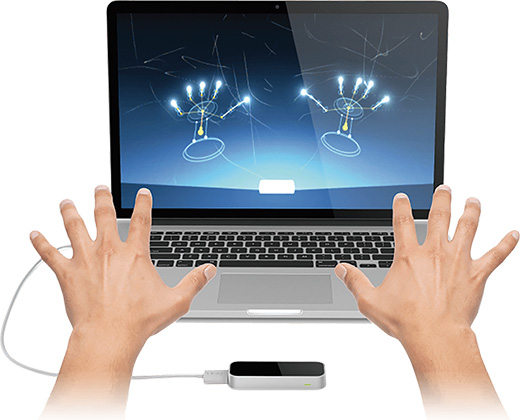Elon student creates interactive games for children

Render of the Leap in action. Note the little piece of hardware plugged in in front of the laptop: this is the sensor and camera.
Peter Traunfeld, a senior Computer Science major, has been researching a way to offer parents a technology that can teach, entertain, and potentially therapeutic benefits to their children. It’s cheap, it can be used at home, and it’s ideal for children that are sensory-seeking. With his own personal code, a Leap Motion sensor, and a Microsoft Kinect, Traunfeld has been spending two years at Elon developing interactive games that combine elements of music, manual dexterity, color, coordination, and creativity.
The Hardware
Traunfeld’s research uses the Leap Motion sensor. A small piece of hardware that plugs into your personal computer’s USB port the Leap uses a combination of infrared light, IR cameras, and a novel tracking algorithm to ‘watch’ how your hands are moving. It can track two hands at once (to within just a few millimeters!) and convert that information into data points in a 3D graphing software.
According to Traunfeld, “you can plug the Leap Motion sensor into your computer and get the raw data in for location on a fingertip: it’s absolute position, it’s angle, and the vector.” The hardware itself costs about $80 and the software is open format. The Leap has been used extensively in partnership with virtual reality technology, gaming, artwork, and increasingly in medical applications. It provides an excellent way of tracking physical progress in rehabilitative environments, monitoring dexterity, and even rewiring the brain after it experiences trauma.
The Kinect is familiar to many of us as the little box that we attach to an Xbox. Where the Leap is good for tracking the minutia of manual movements, the Kinect is excellent for seeing the whole body of a person – and even tracking multiple people simultaneously. The Kinect and the Leap used together allow for an expansion of tracking ability – and, since they both work with a similar infrared system, their separate data is easy to combine
The Research
Traunfeld began his research with this technology two years ago under the mentorship of Dr. Shannon Duvall. Dr. Duvall herself has a daughter who is sensory-seeking due to Smith-Magenis Syndrome. She began looking into this tech as no one had yet used it for children (perhaps that idea of virtual reality as an immersive way of entertaining a child is just a little too Ray Bradbury for some researchers) and Traunfeld loved the idea of doing research that’s essentially creating video games.
To date, Traunfeld has designed games that let you play notes by touching different colored bubbles and a game that allows you to ‘push’ balls around and watch them bounce. In April he presented his research, along with a demo, at the National Council of Undergraduate Research conference in Asheville, NC.
Why?
When asked what the ultimate goal is for this research, Traunfeld said this:
“The whole point of it is that parents can download the software, buy the hardware, just plug it in their house and then customize it for their kid. No two kids are the same. Right now these kinds of interactive spaces are only available in museums where you can only take your kids to see them. But if you wanted to allow parents to take that home and customize it for their kid. It’s something to allow them to interact with things in an intuitive way. If you want a way to create customizable, interactive spaces for your kids that’s not super expensive, this is a great tool. You can sit them down in a playroom with this thing and let them have at it, and it’s pretty fun!”

 Follow
Follow
Really great use of sensor for developing great game for children.